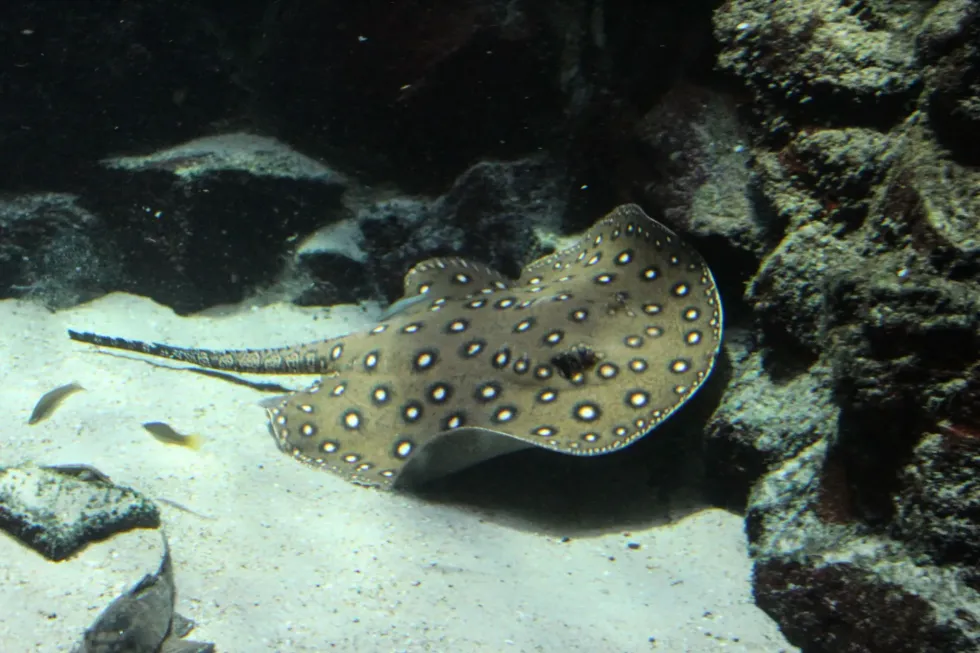River stingrays or freshwater stingrays are fish that are related to sharks. They are members of the family Potamotrygonidae and class Chondrichthyes.
They generally have non-aggressive behavior towards humans. The diet of these animals mainly includes insects, crustaceans, and other invertebrates. Reproduction occurs through internal fertilization following which the females give birth to live young pups.
The pups or the young ones have physical characteristics that differ from the adults. The gestation period for females usually lasts for three months.
Freshwater stingrays have a large disc-shaped body and their eyes are located on top of the disc. They can be found across various parts of the world like South America, Africa, and Australia. The habitat region consists of freshwater habitats as well as sandy-bottomed rivers.
Keeping them as a pet in an aquarium is not a good idea, since they require a large space to move comfortably. There are many species of river stingrays of various genus like the Ocellate river stingray (Potamotrygon motoro), white blotched river stingray, giant freshwater stingray river monsters, among many others.
If you are fascinated by the river stingrays, then you may want to continue reading our other amazing facts about them. If you want to learn more about different animals around the world, check out these wolf eels and lungfish.
River Stingray Interesting Facts
What type of animal is a river stingray?
River stingrays, also known as freshwater stingrays are fishes that can be found across various regions of the world.
What class of animal does a river stingray belong to?
A river stingray or freshwater stingray belongs to the Chondrichthyes class of animals and members of the family Potamotrygonidae.
How many river stingrays are there in the world?
The exact number of river stingrays across the world is not yet known, however, there are as many as 35 species of them, like the Ocellate river stingray (Potamotrygon motoro), or river monsters stingray, among many others.
Many of these animals are killed across various parts of the world, because of the threat they pose and also because of water pollution.
The conservation status for most of the species is not known or data deficient.
Where does a river stingray live?
The river ray can be seen in quite a large number of water habitat regions of Southeast Asia, South America, Africa, and various parts of Australia as well.
What is a river stingray's habitat?
The river sting rays mainly inhabit regions with freshwater habitats. Other than that, they can also be seen in sandy-bottomed rivers, white water, and blackwater. Some species of freshwater stingrays can also be found in shallow water, although, the juvenile population is more in such areas.
Who do river stingrays live with?
The freshwater stingrays are mainly solitary by nature and therefore can be found alone, most of the time. However, sometimes they can also be seen in groups, moving together. They spend the majority part of the day, staying on the river floor, waiting for potential food.
How long does a river stingray live?
The average lifespan of river stingrays is five years in an aquarium. Stingrays, in general, are known to live up to 15-25 years in the wild.
How do they reproduce?
Reproduction or breeding in a freshwater ray occurs through internal fertilization. The hatching of the eggs occurs in the womb of the female fish itself, following which it gives birth to live young ones.
The gestation period usually lasts for three months. During that time, a rich milky substance, known as histotroph is produced internally, inside the female, which is consumed by the developing embryo. The female freshwater stingray usually gives birth to a litter containing two to six young ones.
What is their conservation status?
The conservation status of these creatures vary. The Ocellate river stingray (Potamotrygon motoro) is marked as Data Deficient by the International Union for Conservation of Nature. The Mekong river stingrays are listed as an Endangered species.
River Stingray Fun Facts
What do river stingrays look like?
Freshwater stingrays like most other stingrays have a flat disc-shaped body. The eyes are located on top of the disc, behind which there are openings for respiration.
They have different colored bodies or spots which may range from orange, brown to even black. The Ocellate freshwater stingray (Potamotrygon motoro) for example has a grayish-brown colored body, which is covered with orange spots.
The freshwater stingrays have sharp projections at the tip of their tail which can be quite dangerous and painful for other species or even human beings. Females have a larger size range than males.
How cute are they?
These South American fish are not at all cute, unlike yellow tangs. They may have a beautifully shaped body, however, they are equally dangerous and venomous.
Although they do not readily attack human beings at the first chance, the barbs on their body can cause severe pain to human beings. It is not advisable to keep them as a pet in an aquarium.
How do they communicate?
Native to the regions of South America, the river stingrays are generally solitary by nature. They spend the majority part of the day on the river floor, hunting for prey. Occasionally, they can be found in groups.
How big is a river stingray?
Most of the species of these South American creatures are 30 in (76 cm) in length. The Ocellate river stingray (Potamotrygon motoro) for example has an average size that ranges between 19-23 in (50-60 cm) in length.
They are quite large in size and require a lot of space if you wish to keep one in your aquarium. The disc width of certain individuals can be 18 in (46 cm). They are much bigger than catfish.
How fast can a river stingray swim?
The exact speed of the freshwater stingrays is not known. The giant river monster stingray, however, is known to travel at a speed of 20 mph (32 kph).
How much does a river stingray weigh?
The size of these South American fish, differs from species to species. The Ocellate river stingray (Potamotrygon motoro) found in the Brazilian Amazon, weighs between 22-33lb (10-15 kg), while the river monster freshwater stingray can reach up to a weight of 1100-1300 lb (500-600 kg).
What are the male and female names of the species?
There is no sex-specific name for the different species of stingray.
What would you call a baby river stingray?
Baby or young stingrays are called pups.
What do they eat?
The stingrays, (mainly found in freshwater rivers) eat crustaceans and small invertebrates like insects and other small fishes. They spend a significant amount of time on the river floor to look for food. Once captured, they readily use their strong jaws to eat them. In an aquatic environment, the diet also includes shrimps and earthworms, alongside crustaceans.
Are they poisonous?
Freshwater stingrays are venomous. The barbs at the end of their tails contain powerful venoms, which they use as a safeguard against potential predators. Although they do not directly attack humans and have a rather non-aggressive behavior, however, if they feel threatened they can cause serious pain to human beings.
Would they make a good pet?
Native to the regions of South America, freshwater stingrays are kept as a pet in many households. However, it is not recommended, primarily because they tend to have a shorter lifespan in a confined aquatic space.
They require a huge aquarium to live in, and if not provided so, they can die very quickly. Other than that, the water of the aquarium also needs to be regulated on a daily basis.
The aquarium needs to be properly equipped with proper filtration systems, to get rid of any bacteria that can be toxic to these creatures. The diet of these animals needs to be proper and they have to be fed three times daily.
Did you know...
Freshwater stingrays like the Ocellate river stingray (Potamotrygon motoro) found in the Brazilian Amazon, can be a potential threat to human beings if their numbers are left unchecked. They are illegal in several places, because of the danger they carry with them. The barbs or the spine located on their tail can cause significant damage to human beings.
Freshwater stingrays are edible and can serve as a delicious meal. However, given the risk it takes to capture one, it is probably not advisable.
What are the different types of river stingrays?
Freshwater stingrays (mainly found in freshwater rivers) have a wide range of other species, some of which are the Bigtooth river stingray (Potamotrygon henlei), Ocellate river stingray (Potamotrygon motoro), also known as the Amazon river stingray, short-tailed river stingray (Potamotrygon brachyura) also known as the river monsters giant stingray, because of their huge size, and Mekong river stingray (Hemitrygon laosensis).
The size of all these species differs from one another, based on their types.
How do river stingrays protect themselves?
The freshwater stingray (mainly found in freshwater rivers) makes use of the barb or spine located in its tail to protect itself from potential predators like sharks and other large species. These barbs are powerful enough to penetrate the skin of other animals and can cause extreme pain for them.
All of them belong to the family of Potamotrygonidae but are of varied genera.
Here at Kidadl, we have carefully created lots of interesting family-friendly animal facts for everyone to discover! For more relatable content, check out these ribbon eel facts and amberjack facts for kids pages.
You can even occupy yourself at home by coloring in one of our free printable river stingray coloring pages.









